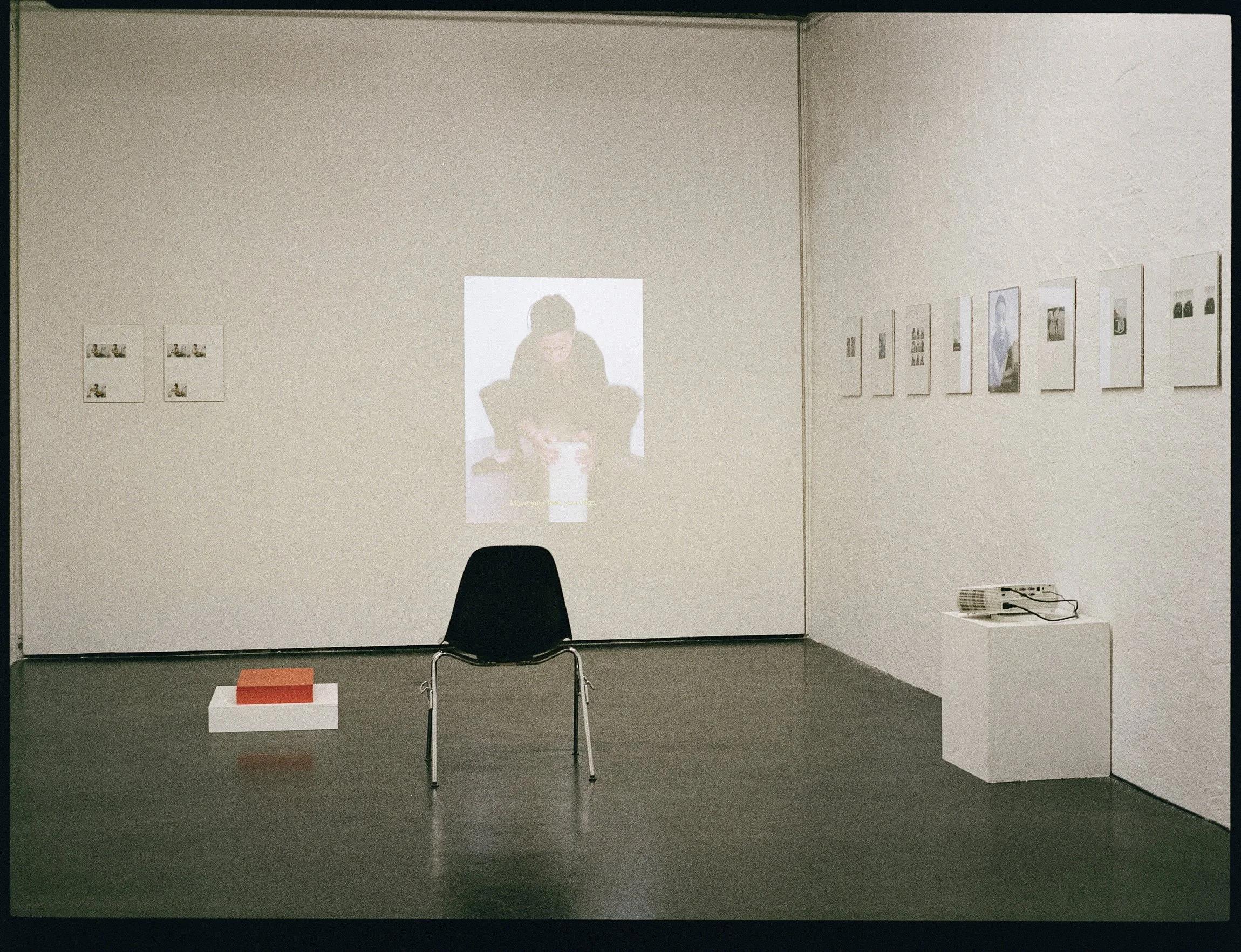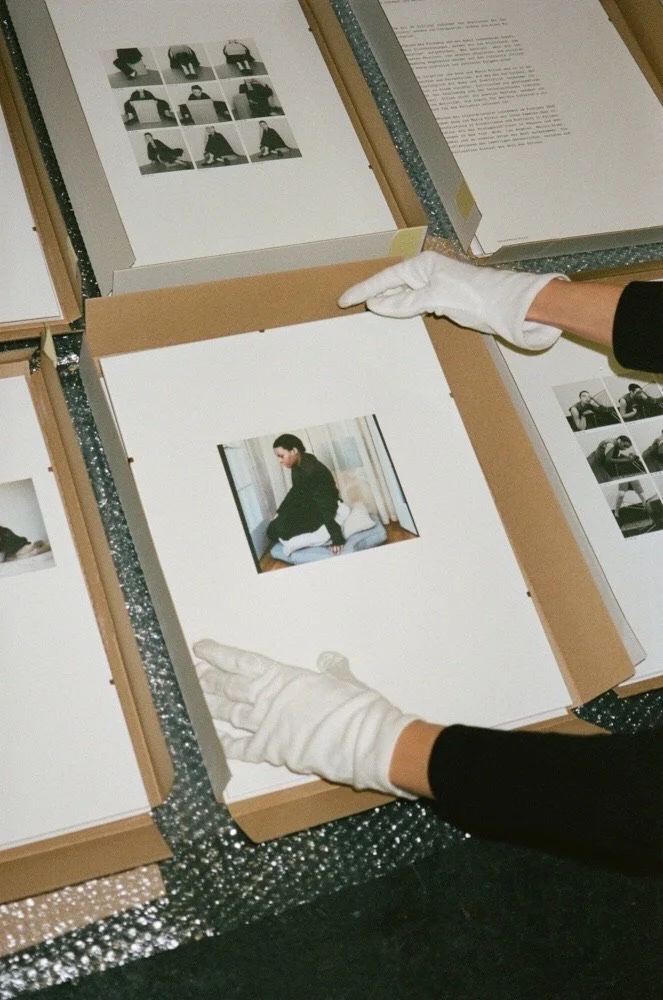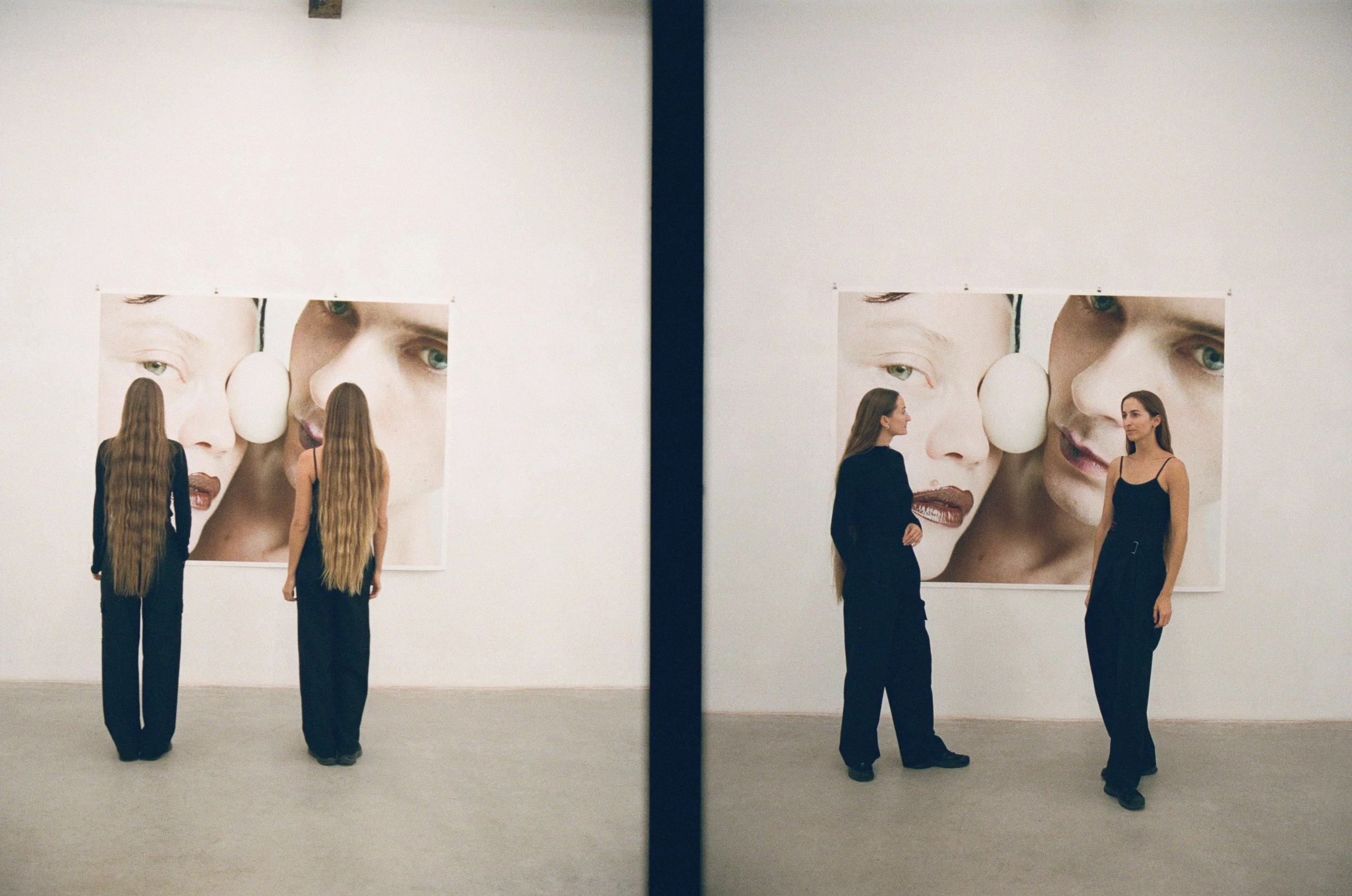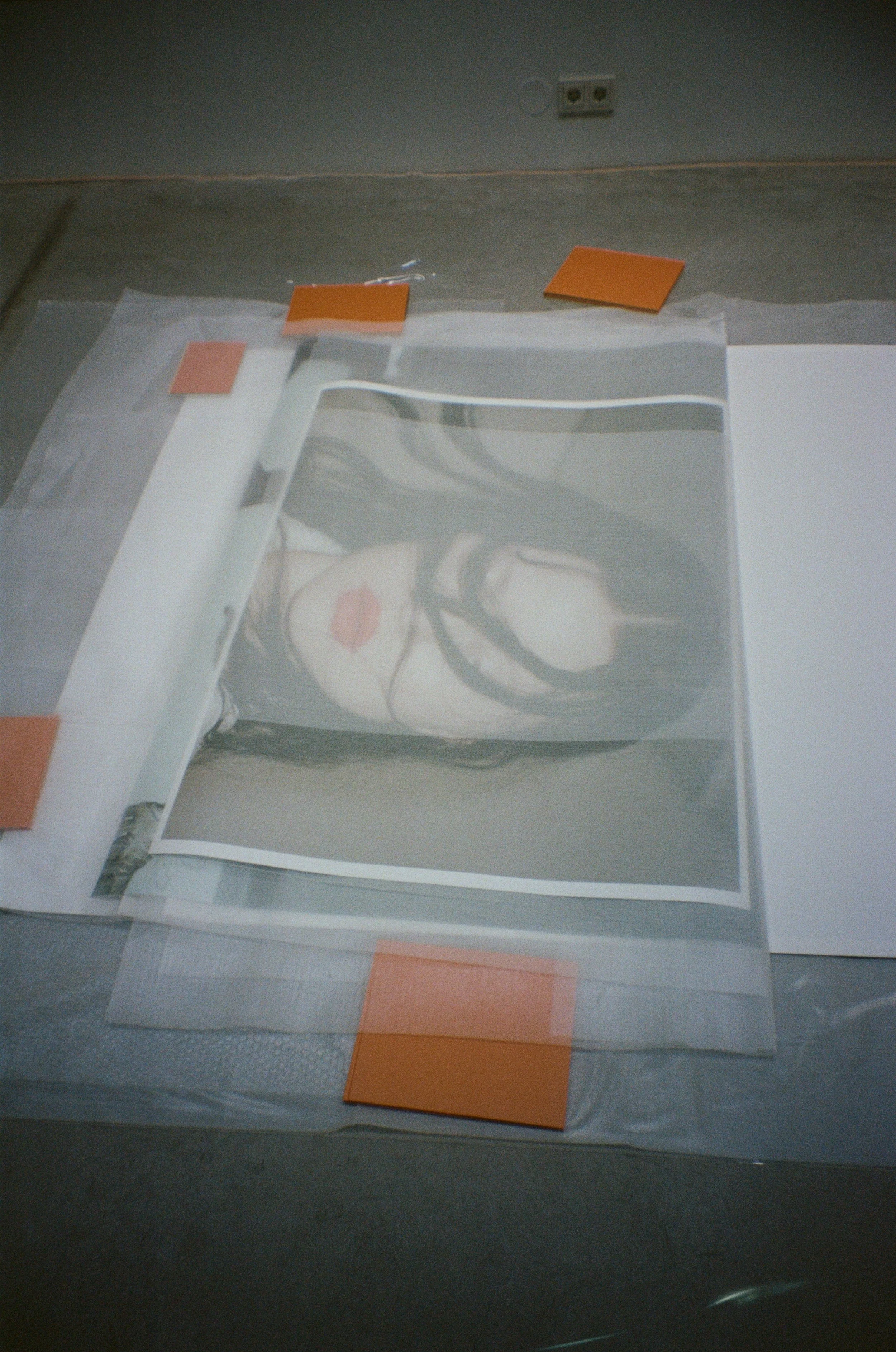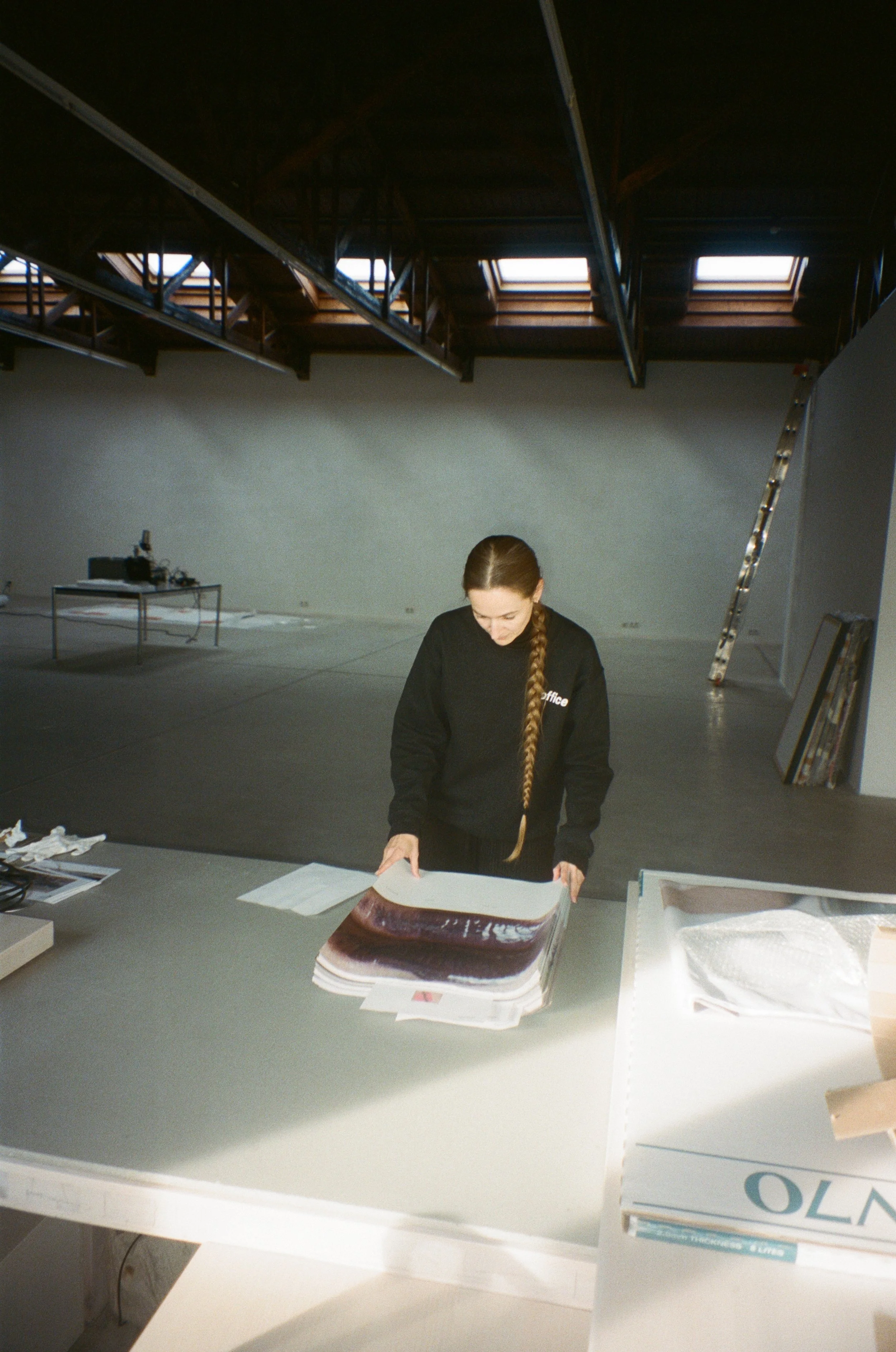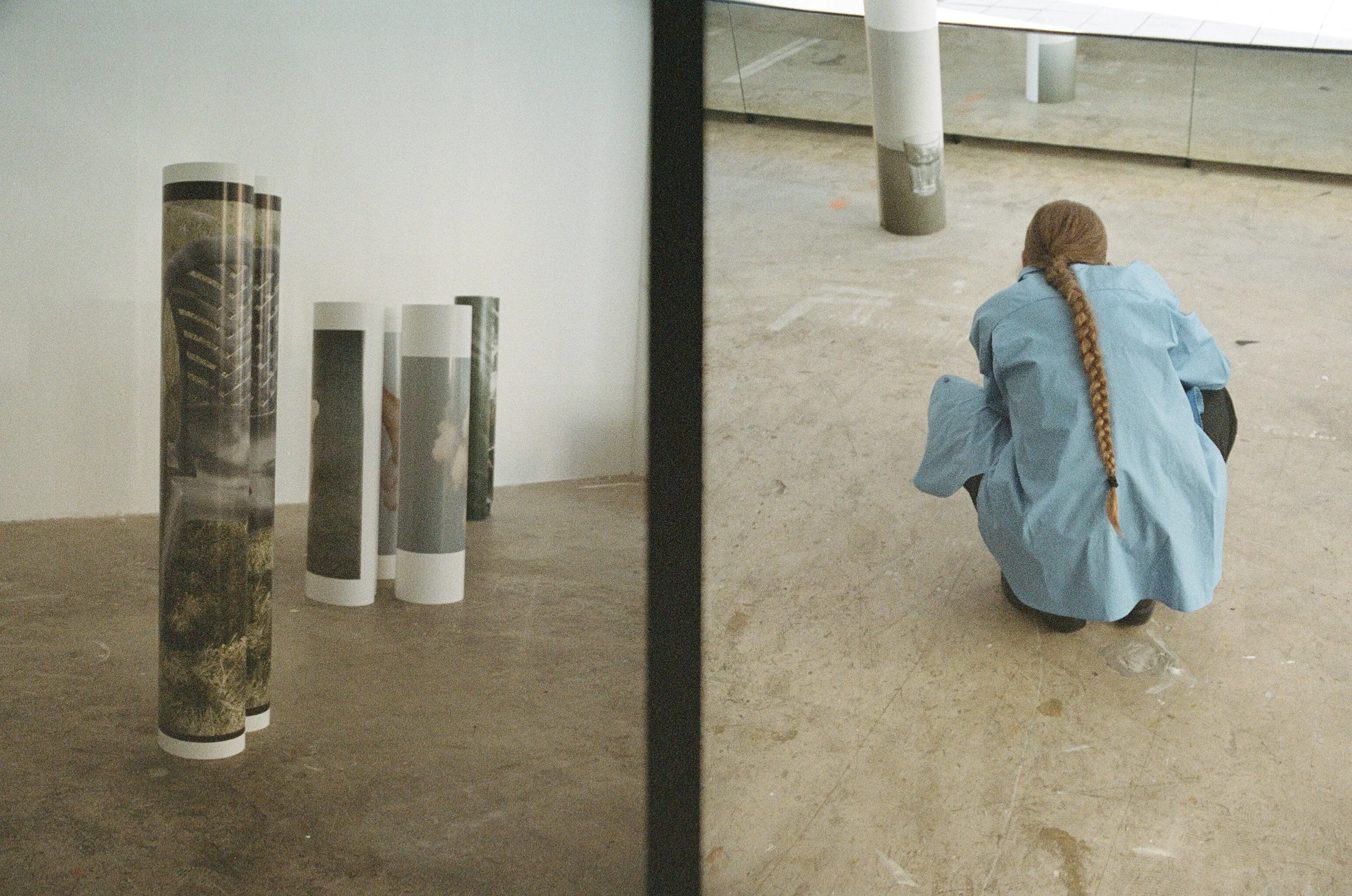Ritsch Sisters
Anna + Maria, please introduce yourself:
We are Anna and Maria, the creative duo behind Ritsch Sisters, working between Vienna and New York. Born and raised in Austria, we explore the tension between the physical, spatial, and emotional in our work. As sisters, our collaboration reflects both our shared history and individual perspectives, blending photography, sculpture, video and sound.
Maria and Anna at VASTO Gallery in Barcelona ©ritschsisters
#1 You are sisters who work together in the field of photography and art. How did it come about that you decided to work as a duo? What are your respective roles in Ritsch Sisters?
We started our collaboration at the beginning of 2020.
Both of us had been working individually in photography and art for the past years, collaborating on and off on projects, mostly when being in the same place.
We’ve always been very close since childhood on and creating things together felt just part of our relationship. So working together as a duo felt like a natural progression.
Today, we work internationally, with Maria living in Vienna and Anna in New York.
As for our roles, they are intentionally fluid. We place a high value on collective authorship, setting aside individual egos in favor of a shared vision. Each of us brings her own unique strengths to the table, and it's this blend of personalities and talents that allows our work to resonate.
#2 Tell us something about your project “The Act Of Sitting”. What role does architecture play in this project?
So we had just officially started our collaboration and then the pandemic hit.
Finding ourselves on two different continents, not knowing when we’d see each other again we had to find new ways of creating together while being apart.
During that time our first project and photobook ‘The Act of Sitting’ came to be.
‘The Act of Sitting’ is a visual exploration of sitting as an Action and Idea. The project was created in 2020 during the first Covid lockdowns, where we portrayed 21 individuals in their homes worldwide over Zoom, about what sitting meant to them in exactly that time we were in.
For us architecture plays a subtle but significant role in this project. As the project evolved during the early days of the pandemic, we both quickly realized how the spaces in which people sat became a reflection of their emotional and mental states. The architecture of each individual's home—whether it was the layout of the room, the furniture, or the natural light—became a crucial backdrop to their personal experience of isolation and reflection.
Rather than focusing purely on portraits, we were equally interested in how architecture framed and influenced these moments of stillness. Sitting, in this context, isn’t just a physical action; it’s an embodied interaction with space.
It created a dialogue between the body, the space, and the act of sitting itself.
The Act of Sitting at Künstlerhaus Bregenz ©ritsch sisters
The Act of Sitting ©ritsch sisters
The Act of Sitting — Yuiko Furuto ©ritschsisters
#3 During your artist residency this summer at Villa Clea you developed the project ’Together Apart - Spaces of Intimacy’. In what ways does the “playful relationship” between your sculptures, the images, and the inhabitants or visitors of the house encourage a new way of perceiving and relating to the space?
‘Together Apart’ is an ongoing series and the title of our latest photo book, published in 2023. The project came to live out of the necessity to find a form of methodology and practice, a common language for our work together while living on separate continents. It is a collection, a form of a continuous archive of images created together and separately put into this context of togetherness, where authorship takes a back seat and the work can evolve into something new, perhaps into something beyond us. It allows for openness and exploration of our individual experiences and to understand where we are in our lives at this particular moment, what we see and why we see what we see.
For our artist residency this summer at Villa Clea we wanted to take this project further. With ‘Together Apart - Spaces of Intimacy’ we wanted to bring this dialogue between us into the context of physical space and explore the shifting dynamics of space, connection, and presence in a way that feels both intimate and playful.
There was something really beautiful and intimate in blurring the boundaries between art and everyday living, to sleep in the space you are exhibiting in.
The works aren't just static objects placed in the space anymore —they interact with the visitors, inviting them to become part of the artwork. The visitors and the inhabitants (us, the owners Allina and Matteo and their two black cats), we find ourselves moving around, adjusting, or even becoming part of the composition, making our own body and presence an integral part of the experience.
One important element in pushing this dialogue and interaction was our decision to move beyond the traditional use of photography as a purely wall-based medium. We wanted to create physical photographic objects that could exist in space, that take up space. We developed these delicate aluminum sculptures that stand independently on the floor, with photographs mounted on them. The idea was to evoke the feeling of slightly bent paper standing up—light, fragile, almost suspended yet taking up physical space. It’s about the idea of breaking the conventional boundaries of the medium, making the photographs feel more immediate and present in the space, and allowing the viewer to engage with them in a more tactile, intimate way.
The experience becomes more like a living, breathing interaction.




Together Apart — Spaces of Intimacy at Villa Clea ©VillaClea
#4 Can you tell us something about one of your latest projects called ‘How Do You Feel Today ?’ What did you enjoy most about this project?
One of our latest projects, How Do You Feel Today?, grew out of the simple, everyday question we’re all asked regularly: "How do you feel today?" It’s such a common, almost trivial question, yet when you really think about it, it carries so much weight—its meaning, its importance, and yet also its unimportance.
We really enjoyed exploring this paradox. It’s kind of fun to think about how a question so ingrained in our daily lives can be so layered, shifting in meaning depending on the context, the person asking it, and the way it’s received.
In How Do You Feel Today?, we wanted to capture the nuances of this simple question and reflect on how it plays a role in our emotional lives, both as something that connects us and something that can feel distant or even meaningless at times.
Collaborating with the performance artists Camilla Schielin and Gergo Farkas, as well as Sabine Reiter doing Make Up, allowed us to translate gestures, movements, and expressions into an experiential rhythm and go deeper into the world of emotions and body language.
It was also a beautiful experience to take this project and transform it into an exhibition, exploring new ways of expressing the idea beyond the initial concept.
How do you feel today? at Galerie Hilger Next ©ritsch sisters
©ritsch sisters
#5 How do you approach curating an exhibition, and what role does the architecture or the space itself play in your process?
For us, curating an exhibition most of the time starts with the space itself. We need to see it first, feel it out, and understand how it connects to our project.
Once we have a sense of the space, we often create a digital rendering to visualize how everything will come together.
In answering this question we realized that our approach to curating is perhaps influenced by our upbringing. Growing up with a father who is an architect, we were always surrounded by architecture and conversations about space. This has definitely shaped how we think about and engage with the environments in which we exhibit. We intuitively draw inspiration from the space’s materials, colors, and sounds, bringing those elements into our work to create a dialogue with the environment.
Anna at Galerie Hilger Next ©ritschsisters
#6 What project or task would you be excited to take on that you haven’t had the chance to do yet?
That's a great question! Actually, we were just discussing how we like to incorporate senses into our works but have never worked with scent before. So maybe there is something to explore here.
#7 How do you see the role of an architect in today's society?
Architects have always been in some way like the silent shapers of our lives. Their influence is intertwined in everything we do, often without us even realizing it. They have the ability to change not just the way we live, but how we think and feel. For us an architect in today’s society carries a deep sense of responsibility and mindfulness, perhaps more than ever. Beyond the focus on sustainability—though that’s obviously crucial in terms of materials, energy use, and environmental impact—architects have a unique power to shape how we live together as a society. The spaces they design influence how we interact with each other, how we feel in our surroundings, and ultimately, how we function as a community. Architecture isn’t just about buildings; it’s about the experience of space and the impact it has on our daily lives.
We do believe architects have a real opportunity, and responsibility, to guide societal behavior through their designs. The spaces we inhabit can stimulate connection or division, inclusion or isolation. In today’s world, with so much emphasis on profit, architects have a chance to prioritize the collective good, creating environments that are socially responsible and promote well-being. It's not just about aesthetics or functionality; it’s about understanding the larger impact their work has on people’s lives and on society as a whole. There’s a lot of trust placed in architects, and it's also important to recognize that the responsibility of creating a socially conscious, sustainable world isn't solely on their shoulders; but somehow architects are in a unique position of influence perhaps more than they even realize.
New Arrangements at DWDS ©ritschsisters
#8 How does your environment (Vienna and New York) influence your work?
Vienna and New York really shape our work in different but complementary ways. Vienna, with its rich history and more classical, slower-paced atmosphere, tends to draw us into a more reflective mindset. It’s a city full of layers—architecture, art, and history all intertwining—and that makes us think a lot about how space impacts our emotions and experiences in a more intimate way. There’s a certain stillness to it that influences us to focus on the personal, the subtle details.
On the other hand, New York’s energy and constant movement bring a completely different vibe. New York is a place where we both feel very free, where it seems we can both liberate ourselves from old patterns and beliefs. The diversity, the fast pace, and the constant flow of ideas challenge us to think on a bigger scale and push us to experiment more. It’s a city that never stops, and that sense of urgency and variety influences how we approach our work in terms of interaction, complexity, and context.
The contrast between these two cities—one more historical and introspective, the other vibrant and ever-changing—helps us blend different perspectives and ideas. It’s like we get to draw from two worlds and let them inform and expand our creative process.
#9 Three things that inspire you at the moment?
Relationship dynamics, movement and body language, live classical music
#10 What do you currently read, watch, listen to?
‘Outside Noise’ by Ted Fendt and ‘The Woman who ran’ by Hong Sang Soo, a friend’s recommendation of two very interesting short films we recently watched together.
We listen to a lot of podcasts on philosophy, psychology, and mindfulness.
A recent one that was quite inspirational is, ‘Das Gehirn-Gießkannenprinzip’ by Gerald Hüther.
A book we both recently read is ‘Ikigai’ by Ken Mogi. It felt like a good reminder of taking your time and focusing on the present moment, doing things with intention and joy.
Anna + Maria at VASTO Gallery in Barcelona ©ritsch sisters
Links
website: ritschsisters.com
Instagram: ritsch.sisters
Photo Credits: ©ritsch sisters
Interview by Caroline Steffen


